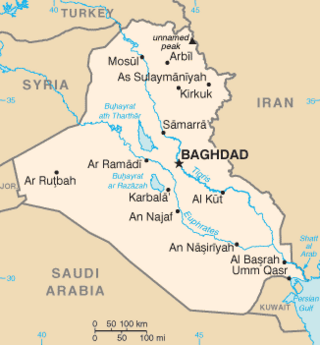Events in the year 2005 in Iraq.
Events in the year 2007 in Iraq.

The 2003 Nasiriyah bombing was a suicide attack on the Italian Carabinieri MSU headquarters in Nasiriyah, Iraq, south of Baghdad on 12 November 2003. The attack resulted in the deaths of 18 Italian servicemembers, mostly members of the MSU Carabinieri, an Italian civilian, and 9 Iraqi civilians and was the worst Italian military disaster since the Second World War. The attack, labeled a "terrorist act" by Italian president Carlo Azeglio Ciampi, was among a string of many attacks on non-American military international targets in Iraq that occurred shortly after the end of major combat operations, including the Jordanian and Turkish embassies, International Red Cross, and UN facilities.
The al-Khilani mosque bombing occurred on 19 June 2007 when a truck bomb exploded in front of the Shia Al-Khilani Mosque in Baghdad, Iraq. At least 78 people were killed and another 218 injured in the blast. The explosion occurred just two days after a four-day curfew banning vehicle movement in the city was lifted after the al-Askari Mosque bombing (2007), and just hours after 10,000 US troops began the Arrowhead Ripper offensive to the north of Baghdad. Because the site was a Shia mosque, the bombing is presumed to have been the work of Sunnis. The Sinak area where the explosion took place was also the targeted by a suicide car bomber on 28 May 2007, which resulted in 21 deaths.
Events in the year 2009 in Iraq.
In 2003, there were 25 suicide bombings executed by 32 attackers.
The August 2009 Baghdad bombings were three coordinated car bomb attacks and a number of mortar strikes in the Iraqi capital, Baghdad, on 19 August 2009. The explosives were detonated simultaneously across the capital at approximately 10:45 in the morning, killing at least 101 people and wounding at least 565, making it the deadliest attack since the 14 August 2007 Yazidi communities bombings in northern Iraq which killed almost 800 people. The bombings targeted both government and privately-owned buildings.
2004 was most notably marked by a series of battles in Fallujah. See Fallujah during the Iraq War.
2005 in Iraq was marked by the first elections held in the country since the fall of Saddam Hussein.

This article details major terrorist incidents in Iraq in 2008. In 2008, there were 257 suicide bombings in Iraq. On February 1, a pair of bombs detonated at a market in Baghdad, killing 99 people and injuring 200. Two other particularly deadly attacks occurred on March 6, and June 17.

The Iraq War started with a US-led invasion on 20 March 2003, causing much damage to the capital city, Baghdad. The war and collateral damage continued for years.
The 19 September 2010 Baghdad bombings were a series of bomb attacks in Baghdad, Iraq that killed at least 31 people, in two neighbourhoods of the capital. Over a hundred more were wounded. On 24 September the Islamic State of Iraq claimed responsibility for the attack.
Events in the year 2011 in Iraq.

The Iraqi insurgency was an insurgency that began in late 2011 after the end of the Iraq War and the withdrawal of U.S. troops from Iraq, resulting in violent conflict with the central government, as well as low-level sectarian violence among Iraq's religious groups.
This list is limited to bombings and does not include other forms of attacks.
In May 2016, the Islamic State conducted a series of bombing attacks in and around Shia neighbourhoods in Baghdad, the capital of Iraq, killing and wounding hundreds. According to ISIL, attacks were aimed at Shia fighters.




